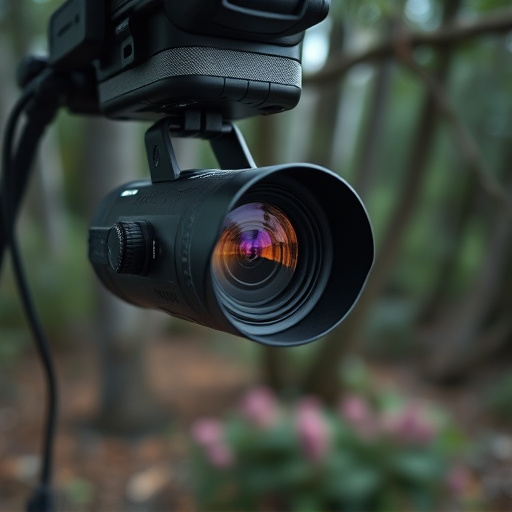Optimizing wireless surveillance systems with motion-activated cameras involves strategic placement, sensitivity adjustments, and advanced algorithms to prevent false alarms. Avoid areas near windows, doors, or natural disturbances. Regular calibration and maintenance ensure accurate location tracking by minimizing false triggers from moving objects or animals, enhancing system reliability in dynamic environments. Focus on specific activity zones for effective monitoring, using proper lighting and camouflage for optimal performance.
“Uncover the secrets of effective wireless surveillance with our comprehensive guide on location detection. From bustling cities to quiet suburban areas, mastering the art of motion sensor technology is key to accurate monitoring. Learn how to choose cameras with advanced false alarm prevention features for peace of mind. Discover strategic placement techniques and environmental factors that enhance system performance. Lastly, explore regular calibration and maintenance practices ensuring optimal accuracy in your surveillance setup.”
- Understand Motion Sensor Technology for Accurate Detection
- Choose Cameras with Advanced False Alarm Prevention Features
- Strategically Place Equipment to Minimize Unwanted Triggers
- Utilize Environmental Considerations for Better Performance
- Regularly Calibrate and Maintain Systems for Optimal Accuracy
Understand Motion Sensor Technology for Accurate Detection
Understanding motion sensor technology is key to achieving accurate location detection with wireless surveillance equipment. Motion-activated cameras, a common component in security systems, rely on sensors that detect changes in light or heat within a defined area. While this technology offers valuable real-time monitoring, false alarms can be a nuisance. To minimize these disruptions, choose sensors with adjustable sensitivity settings and consider using passive infrared (PIR) sensors, which are less prone to triggering by pet movements or passing breeze. Additionally, placing cameras strategically in areas with clear lines of sight and avoiding placement near known sources of constant motion can significantly reduce false alarm rates.
Choose Cameras with Advanced False Alarm Prevention Features
When selecting wireless surveillance equipment, choosing cameras equipped with advanced false alarm prevention features is a smart move. Modern motion-activated cameras now employ sophisticated algorithms to distinguish between genuine movements and common causes of false triggers, such as passing vehicles, pets, or swaying trees. These intelligent systems learn from their surroundings, adapt to various conditions, and minimize false alarms significantly.
By implementing these advanced features, you can ensure that your surveillance system remains reliable and accurate. This is particularly important for locations with high potential for false alarms, ensuring peace of mind and optimizing response times. With the right camera setup, you’ll capture genuine incidents without the hassle of repeated checks or false alerts.
Strategically Place Equipment to Minimize Unwanted Triggers
Strategic placement of wireless surveillance equipment is key to preventing false alarms and ensuring optimal performance. When setting up motion-activated cameras, consider the environment and potential triggers. For instance, placing them near windows or doors might capture movement but also set off alarms unnecessarily due to natural light changes or passing pedestrians. Instead, aim for areas with significant activity specific to your concerns, like unusual foot traffic in a back alley or suspicious behavior around a construction site.
To minimize false alerts, understand the sensitivity settings of your equipment. Adjusting these can help the cameras differentiate between genuine movement and environmental factors. Additionally, consider using motion detection zones to focus on critical areas while ignoring less relevant spaces. This smart placement and fine-tuning will go a long way in maintaining the integrity of your surveillance system and preventing unnecessary alerts.
Utilize Environmental Considerations for Better Performance
When deploying wireless surveillance equipment, environmental factors play a significant role in optimizing performance and reducing false alarm prevention. Understanding these considerations is key to enhancing overall system effectiveness. For instance, placing motion-activated cameras strategically can capitalize on natural terrain features like buildings, trees, or fences, which act as barriers against unauthorized entry, providing clearer views and minimizing interference from the elements.
Additionally, considering lighting conditions ensures optimal camera performance during different times of day. Proper placement near well-lit areas reduces the likelihood of false triggers caused by shadowed objects, while adequate camouflage for cameras in more remote locations can prevent unnecessary alerts. By integrating these environmental considerations into your setup, you enhance the system’s responsiveness and reliability, offering a more accurate and efficient surveillance solution.
Regularly Calibrate and Maintain Systems for Optimal Accuracy
Regular calibration and maintenance are essential practices for wireless surveillance systems to ensure optimal accuracy and performance. Over time, environmental factors and changes in the monitored area can impact the system’s sensitivity and positioning. Calibration allows for adjustments to fine-tune the equipment, ensuring precise location detection. This process involves testing and adjusting various components, including sensors, cameras, and signal receivers, to minimize false alarm triggers caused by moving objects or animals, commonly known as Motion Activated Camera false alarms.
By maintaining regular calibration schedules, you can prevent potential issues that may lead to inaccurate data collection. It’s a proactive approach to keeping your surveillance system reliable, especially in dynamic environments where changes are frequent. Additionally, well-maintained equipment is less prone to unexpected failures, ensuring consistent and accurate location tracking for better overall security.
Wireless surveillance systems, with their motion-activated cameras and advanced features like false alarm prevention, offer enhanced security. By understanding motion sensor technology, strategically placing equipment, considering environmental factors, and maintaining systems, you can minimize false triggers and maximize the effectiveness of your wireless surveillance setup. Regular calibration ensures optimal accuracy, providing peace of mind and reliable protection.
